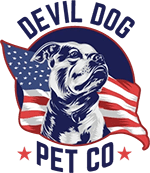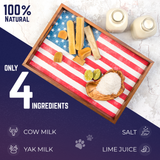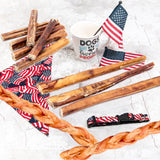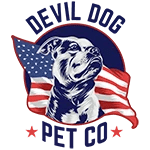As a dog owner, you want your pup to feel safe, happy, and well-adjusted. But if your dog is pacing, barking excessively, or engaging in destructive behavior, it could be a sign of anxiety. Besides being unsettling for you and stressful for your dog, anxiety can escalate into long-term behavioral problems if left unchecked. Taking extreme ownership of your dog’s well-being means recognizing the signs and implementing solutions that help them feel secure.
The good news? Anxiety can often be managed with structure, leadership, and the right tools -- like exercise, safe chewing outlets and calming routines.
Whether your dog freaks out when you leave the house, panics over thunderstorms, or seems constantly on edge, you’re not alone. Many dog owners face the same challenges—but helping your pup isn’t all that complicated. Routine, consistency, and safe, anxiety-relieving activities like chewing can help them relax.
Understanding the causes of dog anxiety
Dog anxiety doesn’t come out of nowhere—it often has clear triggers that leave your pup feeling uneasy or insecure. Whether it’s separation anxiety in dogs, loud noises, or sudden changes to their environment, understanding the "why" behind your dog’s behavior is the first step to helping them feel at ease.
Here are some of the most common triggers:
Separation anxiety in dogs
If your pup barks endlessly or chews on furniture every time you leave the house, it could be a sign they’re struggling with being alone. Dogs are pack animals and often feel lost without their human by their side.
Unfamiliar environments
Moving to a new home or even rearranging furniture can make dogs feel like their world has been flipped upside down. They thrive on familiarity and structure.
Loud noises
Thunderstorms, fireworks, or even the sound of a vacuum cleaner can send some dogs into a tailspin. These unexpected sounds can be overwhelming, especially if your dog isn’t used to them.
Inconsistent leadership
Dogs are happiest when they know what’s expected of them. As John from Devil Dog Pet Co. points out, “Dogs do not do well when they don’t have a routine.” Without clear boundaries, your dog may feel confused and anxious.
Over-coddling
While it’s natural to want to comfort your pup, too much coddling can unintentionally reinforce their anxiety. Amanda explains, “Coddling encourages that anxiety because it makes them less confident.”
Recognizing these triggers will help you be more proactive in supporting your dog.
Signs of anxiety in dogs
Dogs can’t tell you when they’re feeling overwhelmed, but their body language and behavior often speak volumes. Recognizing the signs of dog anxiety early can make all the difference in addressing the root cause and helping them feel secure.
Here are some common physical and behavioral cues that signal your dog might be struggling with anxiety:
Physical signs
A tucked tail, excessive panting or drooling, dilated pupils, raised hackles, and trembling are all ways your dog might be saying, "I’m not okay."
Behavioral signals
Destructive chewing, pacing, avoidance, whining, excessive barking, or hiding are red flags to watch for.
Separation anxiety in dogs
If your dog gets worked up as soon as you grab your keys or leave the house, they may be dealing with separation anxiety.
By paying attention to these signs, you can start to understand your pup’s unique stressors and take steps to help them feel calm and confident.
Structured routines help reduce dog anxiety
Dogs thrive on predictability. Establishing a consistent routine for meals, exercise, rest, and mental stimulation gives them a sense of security and stability. Feeding your dog at the same time daily, incorporating regular walks and playtime, and setting up a designated relaxation spot are simple yet powerful ways to reduce anxiety. Keep their minds engaged with natural dog chews for anxiety, such as yak chews, elk antlers, or bully sticks, which also provide a calming mental outlet.
As our co-founder John explains: “One moment you allow them on the couch, the next you yell at them for being on it... that definitely causes anxiety.” Consistency is key to building trust and reducing confusion.
Ready to help your pup feel more calm? Explore Devil Dog Pet Co.’s collection of chews.
Specific strategies to manage dog anxiety
1. Physical activity is key
When it comes to dog anxiety, exercise is king. Regular exercise helps burn off nervous energy and reduce stress. Walks, play sessions, and interactive games will help keep your dog balanced. Just be mindful of the environment you are bringing them to. If your pup is nervous around other dogs, take time to work with them before you take them to a dog park (and keep in mind that it’s entirely possible that your anxious dog will never be comfortable in a big company of dogs.)
2. Mental stimulation through safe chewing
Chewing is a way for dogs to relieve anxiety and self-soothe. In addition to traditional chews, a dog pacifier can provide gentle, repetitive chewing action that helps anxious dogs stay calm and focused. Devil Dog Pet Co.’s ethically sourced antler chews, yak chews, and bully sticks offer a safe, natural way for dogs to channel stress while also promoting dental health and providing essential nutrition.
Amanda, co-founder of Devil Dog Pet Co., emphasizes: "If they have a way to channel that energy into chewing, it can reduce their anxiety."
3. Create a calm environment
Creating a peaceful environment and removing anxiety triggers (if possible) can go a long way in helping your dog become less anxious. Set up a quiet, safe space for them to retreat to when they are nervous. For example, during a thunderstorm or when you have visitors.
If your dog gets anxious around a specific object and you are okay to part with it, go ahead and take it out of their environment.
If your dog is in an anxious situation (for example, at a vet’s office), you can try yawning to calm your dog down.
Use products and tools available to relax your dog
- Offer long-lasting chews to keep them occupied.
- Use calming treats for dogs to help ease stress during high-anxiety situations.
- Try playing soothing music to create a relaxing environment.
- Ask your vet for dog-calming pheromones
4. Ask for help
If you’ve tried a number of different techniques to alleviate your dog’s anxiety and your dog has not responded to them, it may be time to work with a professional. Start with your local dog trainer and if basic techniques don’t work, reach out to a dog behavioral expert. They will observe your dog and suggest behavior modification routines. You can look for a board-certified dog behaviorist here: American College of Veterinary Behaviorists
It all starts with you
Anxious dogs often lack confidence. As a pet owner, you play a huge role in shaping their sense of security.
- Take “extreme ownership” – Being a responsible dog owner means providing structure and leadership.
- Be consistent – Stick to the rules and routines to prevent confusion.
- Encourage independence – Avoid over-coddling and let your dog build confidence.
"Anxiety management is part of being a responsible dog owner," says Amanda. Taking ownership of your dog's training and well-being is key to building a strong, trusting relationship.
Don’t give up
It is a challenge when you are dealing with an anxious dog. The good news is, there are a number of tools and resources available to help you support your pet in overcoming anxiety. Just like humans, dogs can turn their behavior around with the right support. Keep at it and you’ll be rewarded with a loyal friend.
Helping your dog live a calmer, happier life
Managing dog anxiety starts with structure, consistency, and the right tools. By establishing a predictable routine, providing mental stimulation, and offering safe chews, you can help your dog feel secure and confident.







